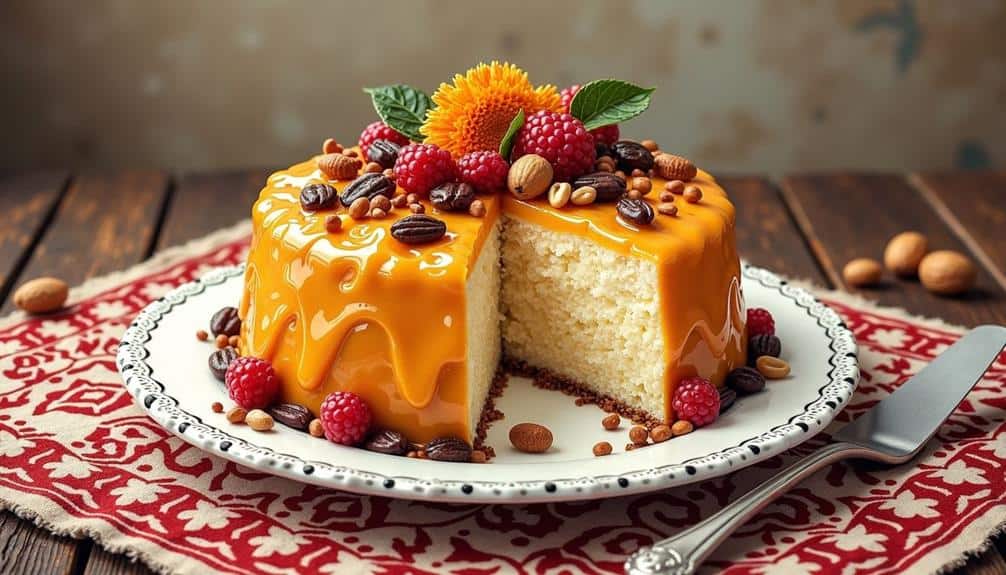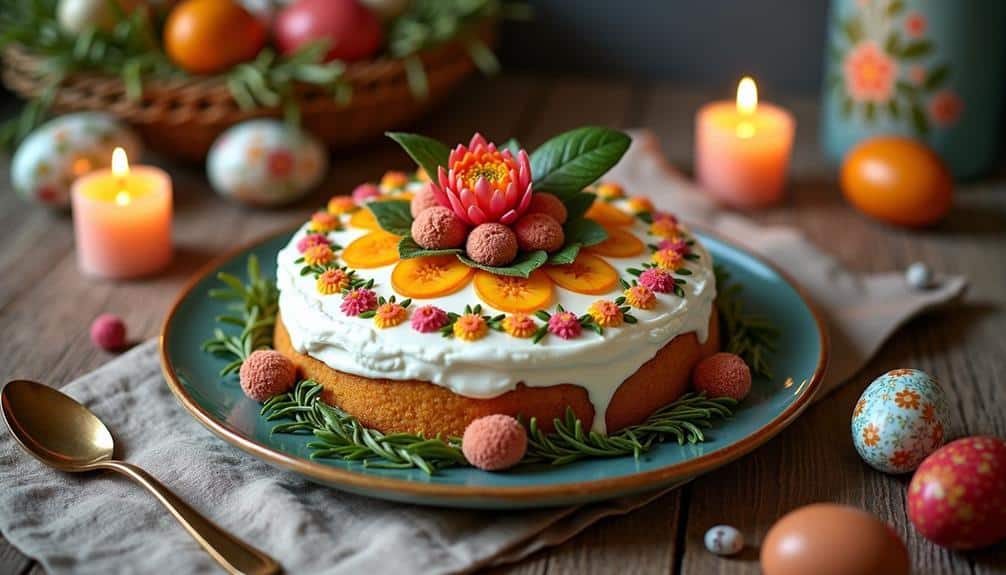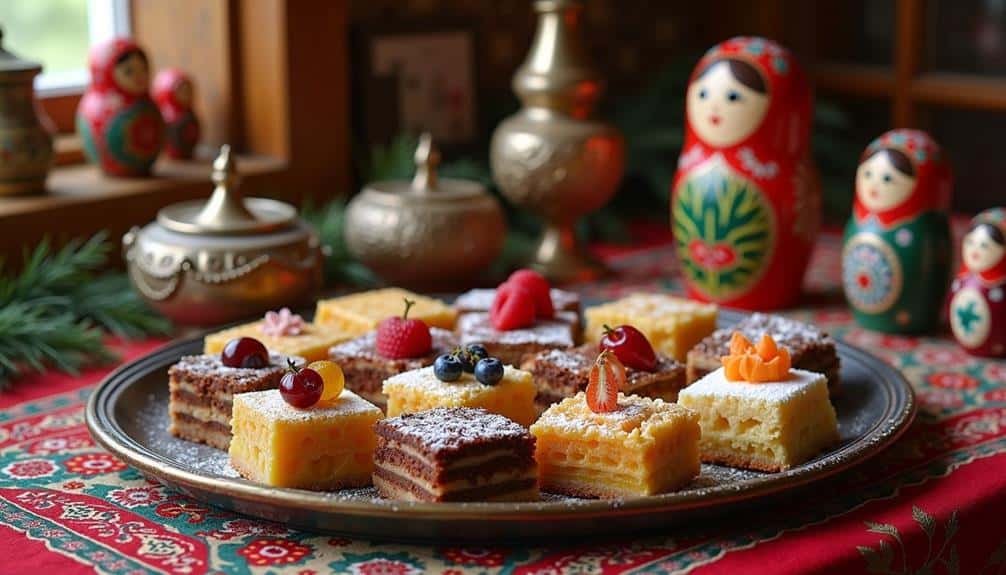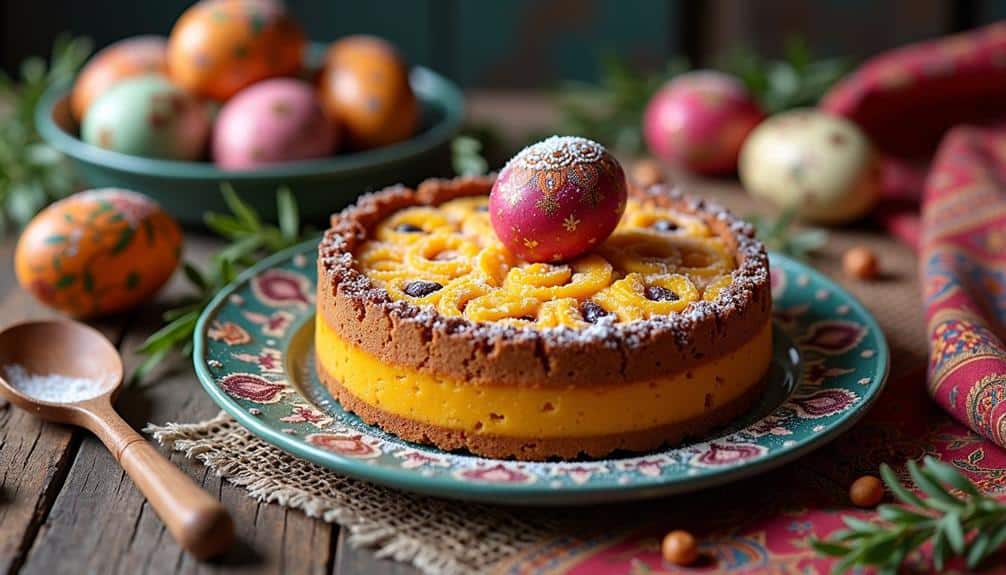When you think of traditional Russian desserts, Pashka stands out not just for its rich taste but for its deep historical and cultural roots. Originating from the early Christian era, this dessert is more than just a treat; it’s a symbol of Christ’s resurrection, crafted meticulously with ingredients that carry significant meanings, like purity and renewal. Typically served during Easter, Pashka fosters a sense of community and continuity, reflecting the rich heritage of Russian customs. But how did this dessert evolve from ancient Slavic traditions, and what makes it so unique in its symbolism and preparation?
Origins of Pashka

Tracing the origins of Pashka reveals a rich tapestry of cultural and religious significance. You’ll find that Pashka, a traditional Russian dessert, is deeply intertwined with the customs of the Orthodox Christian Church. Pashka’s history dates back to the early Christian era when it was crafted to celebrate Easter, symbolizing the resurrection of Christ. This dessert wasn’t merely a culinary delight but also held spiritual meaning, often prepared and consumed with reverence.
Focusing on its culinary evolution, Pashka initially featured simple ingredients: quark (a type of soft cheese), sugar, and dried fruits. Over the centuries, the recipe evolved, incorporating richer elements like butter, cream, and almonds, reflecting regional variations and the availability of ingredients.
You’ll notice that the dessert is traditionally molded in a wooden or plastic pyramid-shaped form, which represents the tomb of Christ, further embedding its religious connotations.
Understanding Pashka’s history provides insight into how food can be a bearer of cultural identity and religious tradition. The dessert’s evolution from modest beginnings to a richer, more complex dish mirrors the broader shifts in culinary practices within Russian society, highlighting the intricate relationship between food and cultural heritage.
Ancient Slavic Traditions
To fully appreciate the cultural roots of Pashka, it’s important to examine the ancient Slavic traditions that predate the Orthodox Christian era.
Ancient Slavs were deeply connected to the natural world, and their lives revolved around the cycles of nature. They celebrated the changing seasons with a variety of folk celebrations and seasonal rituals that honored their deities and guaranteed bountiful harvests.
These celebrations often involved communal feasting, where dairy products like cheese and curd played a significant role due to their symbolic connection to fertility and prosperity. Milk and its derivatives were considered sacred, believed to carry the life force of the earth. Rituals frequently included the preparation and sharing of these foods, embedding them deeply into the collective consciousness.
Seasonal rituals were meticulously timed to align with agricultural milestones, such as planting and harvest festivals. For instance, during spring, a period symbolizing rebirth and renewal, communities would gather to perform rites that invoked the favor of the gods for a fruitful year.
These ancient practices laid the groundwork for many later traditions, including those that shaped the making of Pashka, intertwining it with a sense of communal and spiritual significance.
Symbolism in Ingredients

The ingredients used in Pashka are steeped in symbolism, each element carrying its own profound meaning rooted in both ancient and Orthodox traditions. When you look at the rich, creamy texture of Pashka, you’re not just seeing a dessert; you’re witnessing a tapestry of cultural significance.
Take the primary ingredient, tvorog (a type of curd cheese). Its white color symbolizes purity and the resurrection, a theme central to Easter celebrations.
The addition of butter, with its smooth, rich flavor profile, signifies the abundance and joy of the holiday season. Eggs, often incorporated, represent new life and rebirth, aligning perfectly with springtime and Easter themes.
Honey, another key ingredient, isn’t just for sweetness. It embodies health and prosperity, a wish for the year ahead.
The mix of dried fruits and nuts, like almonds and raisins, adds a complex flavor profile while symbolizing the gifts of nature and the promise of a fruitful harvest.
Even the vanilla and citrus zest often used carry undertones of exotic luxury and festivity.
Religious Significance
You can’t fully appreciate Pashka without understanding its deep religious significance. Pashka isn’t just a dessert; it’s a symbol of spiritual nourishment, reflecting the core beliefs and traditions of Orthodox Christianity.
When you partake in Pashka, you’re not just enjoying a rich, creamy dish; you’re engaging in a ritual that transcends mere sustenance. The ingredients themselves—quark cheese, eggs, butter—are imbued with symbolism, representing purity, resurrection, and renewal.
In the context of religious observance, Pashka is more than food; it’s a medium for spiritual connection. It’s meticulously prepared and shared during festive gatherings, often coinciding with significant religious holidays.
These gatherings aren’t just social events but are spiritual assemblies where faith is reaffirmed and community bonds are strengthened. Every bite of Pashka serves as a reminder of the divine and the eternal cycle of life, death, and rebirth.
Pashka’s Role in Easter

Understanding Pashka’s religious significance enriches its role in the celebration of Easter. This traditional Russian dessert, made from fresh cheese, sugar, and rich dairy products, isn’t just a treat; it’s a symbol of resurrection and new life.
You’ll find that Pashka is intricately linked to the end of Lent, a period of fasting, where its rich ingredients signify the joyous feast that follows.
Pashka presentation is a key aspect of its role in Easter celebrations. Traditionally, it’s shaped like a pyramid, representing the tomb of Christ. The sides are often adorned with religious symbols, such as the Cyrillic letters “XB,” standing for “Christos Voskres,” meaning “Christ is Risen.” This visual symbolism deepens its connection to the holiday.
The variety of pashka flavors also plays a significant role. Commonly, you’ll encounter vanilla, almond, and candied fruit versions, each adding layers of meaning and richness.
These flavors aren’t just for taste; they represent the sweetness of faith and the joy of resurrection. When you partake in Pashka during Easter, you’re engaging in a centuries-old tradition that transcends mere culinary delight, intertwining faith, history, and community celebration.
Traditional Preparation Methods
Preparing Pashka traditionally involves several meticulous steps that guarantee its rich texture and symbolic significance.
You’ll begin with the essential ingredient: tvorog, a type of Russian farmer’s cheese. Start by thoroughly draining the tvorog to remove excess moisture. Then, you’ll incorporate butter, sugar, and egg yolks, blending these together with precise mixing techniques to ascertain a smooth, creamy consistency.
Next, you’ll add heavy cream, which you should whip separately before folding it into the mixture. This step requires careful attention to maintain the airy texture of the cream without deflating it.
Vanilla, nuts, and dried fruits are then mixed in, adding both flavor and texture.
Once your mixture is ready, you’ll need a special mold, traditionally wooden or plastic, called a pasotchnitsa. Line it with cheesecloth before filling it with the mixture, ensuring an even distribution.
Place a weight on top to press the mixture, allowing it to set in a cool place for at least 24 hours.
Regional Variations

Regional variations of Pashka highlight the cultural diversity and culinary ingenuity found across Russia. In Moscow, variations often incorporate luxurious ingredients like candied fruits, almonds, and rich creams, reflecting the city’s historical ties to opulence and trade. These Moscow variations are typically adorned with intricate patterns and vibrant colors, making them the centerpiece of festive presentations.
As you move eastward, Siberian twists on Pashka offer a different experience. Here, regional ingredients like wild berries and local honey infuse the dessert with unique flavors that reflect Siberia’s natural bounty. These ingredients not only add a distinct taste but also embody the seasonal adaptations necessary for survival in harsher climates.
Family recipes in various regions often include local flavors handed down through generations, capturing the essence of each locale’s culinary heritage. For instance, in southern Russia, you might find Pashka made with fresh dairy products from local farms, showcasing the region’s agricultural richness.
Historical influences also play a significant role. Many regional Pashka recipes have evolved over centuries, blending elements from neighboring cultures and adapting to available resources.
This rich tapestry of regional variations guarantees that Pashka remains a beloved and ever-evolving symbol of Russian festivity and tradition.
Modern Adaptations
While regional variations of Pashka pay homage to Russia’s diverse cultural landscape, modern adaptations bring this traditional dessert into the contemporary culinary world.
You’ll find that chefs now experiment with contemporary flavors, blending ingredients like dark chocolate, matcha, or even tropical fruits into the classic Pashka base. This infusion of new tastes not only modernizes the dessert but also broadens its appeal to those unfamiliar with its rich history.
Creative presentations elevate Pashka to a gourmet experience. Instead of the conventional pyramid shape, you might see Pashka molded into intricate designs, or even deconstructed into layers within elegant glassware.
This reimagining transforms the dessert into a visually stunning centerpiece, perfect for modern dining tables.
Adapting Pashka doesn’t just stop at flavors and presentation. The traditional dairy-rich recipe can be reworked to accommodate contemporary dietary preferences.
Vegan and lactose-free versions, made with ingredients like coconut milk or cashew cream, make this historic dessert accessible to everyone.
Pashka in Russian Culture

Renowned for its rich, creamy texture and deeply rooted traditions, Pashka holds a special place in Russian culture, especially during Easter celebrations. This dessert isn’t just a sweet treat; it’s a symbol of renewal and festivity. When you’re preparing Pashka, you’re participating in a ritual that spans generations.
Traditional pashka recipes often call for ingredients like farmer’s cheese, butter, eggs, and dried fruits, which come together to create a dish that’s both decadent and meaningful.
Pashka presentation is equally significant. The dessert is typically shaped using a special wooden mold called a пасочница (pasochnitsa), which imprints religious symbols such as the Orthodox cross. This not only enhances its aesthetic appeal but also reinforces its cultural and spiritual significance.
When you see a beautifully adorned Pashka on the Easter table, you’re witnessing a blend of artistry and tradition.
Understanding Pashka in Russian culture means recognizing its dual role as both a culinary delight and a cultural artifact. The meticulous preparation and elaborate presentation speak volumes about its place in Russian society.
Celebratory Customs
Celebratory customs surrounding Pashka are vibrant and deeply meaningful, forming the heart of Russian Easter festivities. When you take part in these traditions, you’ll notice that festive gatherings are the cornerstone of the celebration. Families and friends come together to share in the joy and renewal that Easter represents.
The preparation of Pashka itself is a communal activity, often involving multiple generations. Family recipes, passed down through the years, are treated with reverence and care, ensuring that the dessert retains its authentic taste and significance.
In these gatherings, the presentation of Pashka is a moment of pride. It’s typically adorned with religious symbols, such as the letters “XB” for “Christos Voskres” (Christ is Risen), adding to its cultural resonance.
You’ll find that the making of Pashka is an act of devotion and creativity, embodying the spirit of the occasion. The dessert is usually accompanied by other traditional foods, creating a rich tapestry of flavors that enhance the festive atmosphere.
Conclusion
In celebrating Pashka, you’re not just enjoying a dessert but also partaking in a rich tapestry of history, faith, and community. This pyramid-shaped treat, laden with symbolism, captures the essence of Easter and reflects centuries of tradition. By savoring its flavors, you connect with ancient Slavic roots and Orthodox Christian beliefs, while also embracing modern adaptations. Pashka’s enduring presence at festive gatherings underscores its cultural significance, reminding you of the shared bonds and heritage that define Russian culture.




